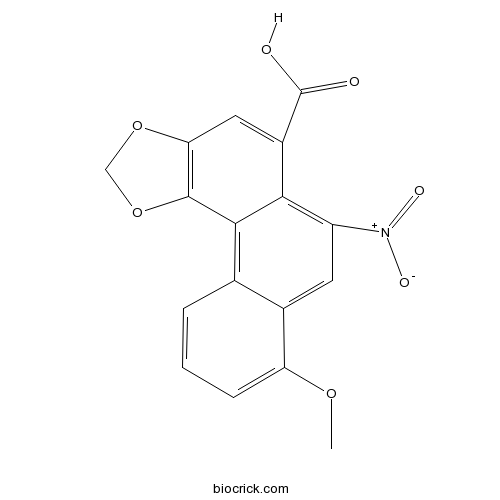Aristolochia manshuriensis
Aristolochia manshuriensis
1. The products in our compound library are selected from thousands of unique natural products; 2. It has the characteristics of diverse structure, diverse sources and wide coverage of activities; 3. Provide information on the activity of products from major journals, patents and research reports around the world, providing theoretical direction and research basis for further research and screening; 4. Free combination according to the type, source, target and disease of natural product; 5. The compound powder is placed in a covered tube and then discharged into a 10 x 10 cryostat; 6. Transport in ice pack or dry ice pack. Please store it at -20 °C as soon as possible after receiving the product, and use it as soon as possible after opening.
Natural products/compounds from Aristolochia manshuriensis
- Cat.No. Product Name CAS Number COA
-
BCN6262
Aristolochic acid A313-67-7
Instructions

Oral administration of Aristolochia manshuriensis Kom in rats induces tumors in multiple organs.[Pubmed: 30008395]
Aristolochia manshuriensis Kom (AMK), belonging to the Aristolochia family, is traditionally used in China to remove heart fire, promote dieresis, restore menstruation, and enhance milk secretion. The active constitutes of AMK are aristolochic acids (AAs, I and II) that are reported to cause serious side effects including nephrotoxicity and carcinogenicity.
Pollen ultrastructure in Aristolochia manshuriensis and A. contorta (Aristolochiaceae).[Pubmed: 29511834]
Pollen ultrastructure has been studied in two relict and rare species of the genus Aristolochia, A. contorta Bunge and A. manshuriensis Kom. (Aristolochiaceae). Both species have inaperturate, spheroidal, sometimes distally monocolpate or distally bicolpate pollen grains. The equatorial and polar axes of pollen grain in A. manshuriensis are 48.5 and 44.0 μm, respectively. The percentage of defective pollen grains in A. manshuriensis is 3.4%. The fossulate, perforated exine is up to 2.3 μm in thickness; the sexine and the nexine are almost equal in thickness. In A. contorta, the equatorial axis of pollen grain is 36.6 μm: the defectiveness percentage, 24.5%. The exine is verrucate, up to 0.3 μm in thickness, while the sexine is two to three times thicker than the nexine. The pollen germination experiments have shown that pollen of A. manshuriensis, in contrast to A. contorta, can germinate in 10-20% sucrose at 22°С. These data and the high percentage of pollen defectiveness in A. contorta indicate that the androecium function in this species is reduced. The reduction of the androecium function is evidenced by a small amount of pollen grains in anthers or empty anthers and a high percentage of defective pollen grains.
Omeprazole Alleviates Aristolochia manshuriensis Kom-Induced Acute Nephrotoxicity.[Pubmed: 27716846]
Aristolochia manshuriensis Kom (AMK) is a member of the Aristolochiaceae family and is a well-known cause of aristolochic acid (AA) nephropathy. In this study, we investigated the potential of omeprazole (OM) to alleviate AMK-induced nephrotoxicity. We found that OM reduced mouse mortality caused by AMK and attenuated AMK-induced acute nephrotoxicity in rats. OM enhanced hepatic Cyp 1a1/2 and renal Cyp 1a1 expression in rats, as well as CYP 1A1 expression in human renal tubular epithelial cells (HKCs). HKCs with ectopic CYP 1A1 expression were more tolerant to AA than the control cells. Therefore, OM may alleviate AMK-mediated acute nephrotoxicity through induction of CYP 1A1. We suggest that the coadministration of OM might be beneficial for reducing of AA-induced nephrotoxicity.
Rapid Identification of Officinal Akebiae Caulis and Its Toxic Adulterant Aristolochiae Manshuriensis Caulis (Aristolochia manshuriensis) by Loop-Mediated Isothermal Amplification.[Pubmed: 27379153]
Mu-tong (Akebiae Caulis) is a traditional Chinese medicine commonly used as a diuretic and antiphlogistic. A common adulterant of Mu-tong is Guan-mu-tong (Aristolochiae Manshuriensis Caulis), which is derived from the stem of Aristolochia manshuriensis Komarov, and contains carcinogenic aristolochic acids. We used an alternative technique, loop-mediated isothermal amplification (LAMP), to differentiate Mu-tong from Guan-mu-tong because LAMP is quick, highly sensitive, and specific. We designed a set of four common primers (G-F3, G-B3, G-FIP, and G-BIP) and a loop primer (G-LB) for LAMP based on the internal transcribed spacer 2 sequence of Ar. manshuriensis. We successfully amplified the LAMP assays and visual detection occurred within 60 min at isothermal conditions of 65°C. The LAMP reaction exhibited a tenfold increase in detection (4.22 pg/μl DNA) over conventional polymerase chain reaction demonstrating that LAMP is a useful technique to detect Guan-mu-tong. We conclude that the LAMP technique is a potentially valuable safety control method for simple and efficient discrimination of Mu-tong from its adulterant Guan-mu-tong.
Possible role of mitochondrial injury in Caulis Aristolochia manshuriensis-induced chronic aristolochic acid nephropathy.[Pubmed: 27250112]
The proximal tubular epithelial cells (PTECs) are the primary target of aristolochic acids and especially vulnerable to mitochondrial injury from insults of toxic xenobiotics.
Aristolochia manshuriensis Kom ethyl acetate extract protects against high-fat diet-induced non-alcoholic steatohepatitis by regulating kinase phosphorylation in mouse.[Pubmed: 26726030]
Aristolochia manshuriensis Kom (AMK) is an herb used as a traditional medicine; however, it causes side effects such as nephrotoxicity and carcinogenicity. Nevertheless, AMK can be applied in specific ways medicinally, including via ingestion of low doses for short periods of time. Non-alcoholic steatohepatitis (NASH) induced the hepatocyte injury and inflammation. The protective effects of AMK against NASH are unclear; therefore, in this study, the protective effects of AMK ethyl acetate extract were investigated in a high-fat diet (HFD)-induced NASH model. We found decreased hepatic steatosis and inflammation, as well as increased levels of lipoproteins during AMK extract treatment. We also observed decreased hepatic lipid peroxidation and triglycerides, as well as suppressed hepatic expression of lipogenic genes in extract-treated livers. Treatment with extract decreased the activation of c-jun N-terminal kinase 1/2 (JNK1/2) and increased the phosphorylation of extracellular signal-regulated kinase 1/2 (ERK1/2). These results demonstrate that the protective effect of the extract against HFD-induced NASH occurred via reductions in reactive oxygen species production, inflammation suppression, and apoptosis related to the suppression of JNK1/2 activation and increased ERK1/2 phosphorylation. Taken together, these results indicate that that ethyl acetate extract of AMK has potential therapeutic effects in the HFD-induced NASH mouse model.


